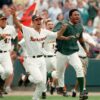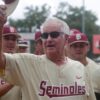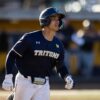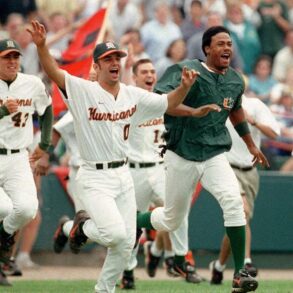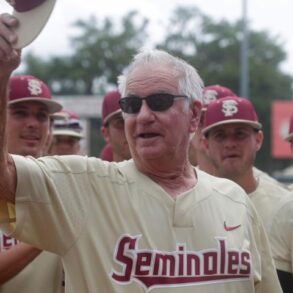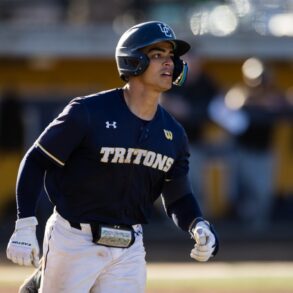Welcome back, college baseball! While major-league spring training remains in its nascent stages in mid-February, such is not the case at the collegiate level. In fact, the Division I baseball regular season begins Friday, with hundreds of contests across the country.
With the College World Series in Omaha our final destination five months from now, here are six storylines to watch this spring in the wide world of D-I baseball.
Can Tennessee defend its title with a completely new roster?
When head coach Tony Vitello was hired before the 2018 season, the Vols hadn’t qualified for the NCAA tournament since 2005. Vitello has since built the program into a full-blown powerhouse, culminating in the school’s first national championship last year and a subsequent monster extension for Vitello, making him the highest-paid head coach in college baseball.
Now the Vols are tasked with defending their crown with a drastically different roster after a staggering amount of talent from last year’s historic squad moved on from the program. On offense, Tennessee will need to replace five hitters who posted an OPS above 1.000 with at least 20 home runs: 2B Christian Moore, 1B Blake Burke, 3B Billy Amick, LF Dylan Dreiling and RF Kavares Tears, all of whom were selected in the first five rounds of the 2024 MLB Draft. On the mound, six of Tennessee’s top seven arms by innings pitched either graduated or were drafted, so the pitching staff will also have a new look.
That’s not to say the 2025 Vols will lack talent. Strong recruiting and a handful of exciting pickups in the transfer portal have resulted in another stellar roster for Vitello to work with. Shortstop Dean Curley returns to anchor the lineup after a breakout freshman year, and he could be one of the first sophomore-eligible players selected in the 2025 draft. Top transfers Gavin Kilen (Louisville) and Andrew Fischer (Ole Miss) will handle second and third base, respectively, and could be early picks in July as well. Veteran Hunter Ensley returns in center field for his fifth year with the program, and Jay Abernathy could make an immediate impact offensively as a freshman. On the mound, transfer southpaw Liam Doyle (Ole Miss) and returning right-handers Nate Snead and Marcus Phillips will lead the way, with several other promising arms filling out the rest of the staff.
Tennessee certainly has its work cut out if it wants to become the first Division I school to repeat as champion since South Carolina in 2010 and 2011. But it’d be foolish to bet against Vitello leading another deep playoff run.
What does the Texas A&M-Texas rivalry look like after an eventful summer?
As Texas A&M was chasing a national championship in Omaha last June, whispers grew quite loud about Aggies head coach Jim Schlossnagle having his eyes on the head job at the University of Texas, which opened up during the College World Series. Schlossnagle worked closely with Texas AD Chris Del Conte when both were at TCU from 2009 to 2017, and it was believed that Schlossnagle had always viewed Texas as his dream job.
Sure enough, just one day after Texas A&M lost to Tennessee in the College World Series finals, the rumors were validated with the announcement that Schlossnagle and his top three assistants — recruiting coordinator Nolan Cain, pitching coach Max Weiner and hitting coach Michael Earley — were heading to Austin to take over the Longhorns program in one of the more stunning coaching moves the sport has ever seen.
This was already a seismic move considering the rivalry between the two schools, but things took another twist a week later, when it was announced that the Aggies had decided to fill their suddenly vacant position by retaining the 36-year-old Earley, despite his having zero head-coaching experience. But Earley’s excellent reputation and close connection with the Aggies roster made him the strongest choice, particularly during a time of such unexpected uncertainty.
The decision to elevate Earley clearly paid off in the short term, with nearly all of the team’s key returners opting to stay put rather than hit the transfer portal. This remarkable retention included a potential 2025 No. 1 overall pick in center fielder Jace LaViolette, a top 2026 draft prospect in star sophomore third baseman Gavin Grahovac and even ace lefty Ryan Prager, who turned down significant money from the Angels after being drafted in the third round to return to lead the Aggies’ pitching staff. This tremendous trio plus a wealth of depth has the Aggies ranked No. 1 entering the 2025 season, according to D1baseball.com, a remarkable reality after all the drama last summer. Meanwhile, Schlossnagle’s Longhorns are ranked No. 19, with a solid roster that has clear upside but also key questions that will need to be answered.
Further enhancing this subplot is Texas’ move to the SEC, meaning these two historic rivals are once again conference foes, just as they were for years in the Big 12. Although Schlossnagle’s return to College Station won’t happen until 2026, the Longhorns will host the Aggies for three games April 25-27. Circle that series on your calendar — things could get spicy.
How will Oregon State’s first season as an independent go?
Conference realignment has dramatically altered the landscape of nearly every college sport, and baseball is no exception. This latest round of restructuring resulted in a particularly fascinating decision for one of the sport’s most premier programs in Oregon State. The dissolution of the Pac-12 meant different things for different schools, with the majority finding new homes in other conferences. To that end, most of Oregon State’s athletic programs accepted invitations to join the West Coast Conference, but the Beavers baseball team opted instead to compete as an independent.
This season, with no conference affiliation and thus no conference tournament at the end of their schedule, the Beavers will not have access to an automatic bid to the NCAA tournament. But Oregon State is more than talented enough to earn an at-large bid to the tourney; it enters the season ranked No. 7 and, notably, the only non-ACC, non-SEC team in the top 10. And without a conference to dictate their slate, the Beavers have constructed a creative and unique schedule that features stellar competition all spring, providing ample opportunities for them to prove their mettle.
The 2024 Beavers produced seven MLB draft selections, including No. 1 overall pick Travis Bazzana. Replacing Bazzana’s gargantuan production is no small task, but the 2025 team boasts another enticing wave of pro-caliber talent. Shortstop Aiva Arquette, a transfer from the University of Washington, is the headliner as a possible top-10 pick, and third baseman Trent Caraway could also play his way into the first round. Outfielders Gavin Turley and Dallas Macias, plus left-hander Nelson Keljo, could also hear their names called in the first few rounds come July.
The Beavers haven’t been to the College World Series since they won it all in 2018. Maybe this year’s team can break through and return to Omaha — even if it takes an unusual path to get there.
Will Rintaro Sasaki live up to the hype?
It was roughly a year ago that Sasaki, Japan’s all-time high school home run king, made the unprecedented decision to bypass Japan’s NPB Draft and enroll early at Stanford University. As one of the most accomplished prep players Japan has ever seen — and one who played for the same high school that produced Shohei Ohtani and Yusei Kikuchi — Sasaki could’ve followed the traditional path taken by so many of his fellow countrymen and starred in his home country’s top league before making the leap to MLB.
Instead, with the goal of playing in the big leagues sooner rather than later, Sasaki opted to come stateside straight out of high school and compete at the NCAA level. After taking classes at Stanford and getting integrated with the team in the spring despite not yet being on the roster, Sasaki played in the Appalachian and MLB Draft Leagues, two high-level wood bat summer leagues. He then continued to impress during fall practices in Palo Alto, setting up one of the more highly anticipated freshman seasons in Division I history.
Sasaki will turn 21 in April of next year, meaning he’ll be eligible for the 2026 MLB Draft as a sophomore. But before we pencil him in as a first-round pick, Sasaki must prove his much-hyped hitting ability against other top domestic amateur prospects. With Stanford moving to the ACC, he’ll certainly have that opportunity: The Cardinal’s schedule features several high-profile matchups, including visits to No. 6 North Carolina, No. 2 Virginia and No. 15 Clemson, as well as home series against No. 14 Wake Forest and No. 11 Duke.
No other freshman carries the same level of intrigue as Sasaki, but he won’t be the only first-year player worth watching closely this spring. LSU managed to get three of the top players from the 2024 high school class on campus in outfielder Derek Curiel, catcher Cade Arrambide and right-hander William Schmidt; Curiel should be in the lineup right away. Florida State has two first-year sluggers in Hunter Carns and Myles Bailey who could help backfill some of the power lost when Seminole stars James Tibbs and Cam Smith were both taken in the first round last July.
The Rays selected shortstop Tyler Bell with the 66th pick last year, but he surprisingly spurned them in favor of honoring his commitment to Kentucky, where he joins an ascendent Wildcats program. Chris Levonas also opted to matriculate despite the Brewers drafting him with the 67th pick; he’s now a part of a loaded Wake Forest pitching staff that features another fantastic freshman right-hander named Duncan Marsten. And keep an eye on Vanderbilt’s Brodie Johnston. He wasn’t nearly as highly touted as the aforementioned names, but a huge summer against older competition in the Appalachian League and a standout fall have him primed to contribute right away as the Commodores’ starting third baseman.
Who will climb to the top of MLB Draft boards?
College players accounted for 13 of the first 15 selections in the 2024 draft, including the first eight. We’re a long way from finding out exactly how college-heavy the top of the 2025 draft will end up being — this year’s crop of high school players looks markedly stronger than last year’s — but three Division I stars currently stand atop the class as the likeliest trio to come off the board first: A&M center fielder Jace LaViolette, Florida State left-hander Jamie Arnold and UC Santa Barbara right-hander Tyler Bremner. LaViolette has prodigious power and the athleticism to stick in center, Arnold attacks with an elite fastball and strong secondaries from an unusual arm slot, and Bremner pairs high-end velocity with an exceptional changeup.
Will those three hold serve all spring and hear their names called first in July? Or will others emerge as worthwhile challengers? Curley, Arquette, North Carolina catcher Luke Stevenson, Indiana outfielder Devin Taylor, Clemson center fielder Cam Cannarella, Auburn catcher Ike Irish and Wake Forest shortstop Marek Houston are all strong candidates to play their way into the top tier of this year’s class over the course of the season, so stay tuned.
This post was originally published on this site be sure to check out more of their content.


